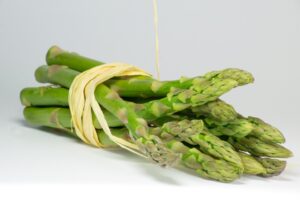Organic Asparagus (green)
Season: Grown in California! February to June
Flavor: Its flavor is mildly sulphuric, mostly sweet and slightly nutty, more-so when grilled.
Storage: Store asparagus in a bag in the refrigerator, preferably in the crisper between 32 and 36 degrees F. Properly stored asparagus can last between 1 and 2 weeks. Things can go downhill for asparagus pretty rapidly, especially the tips, so try to eat it as soon as possible. If you must wait, you can preserve your spring-y bounty by trimming the ends of the stalks and standing the bunch (still bound together — if you bought them loose, then tie them up for balance) in a cup of water in the refrigerator.
How to use: Some people peel asparagus, but unless you are dealing with exceptionally woody stalks, it is generally unnecessary. However, you absolutely should trim the end of each spear. The question is, how much should you trim before preparing? This tip takes the guesswork out of trimming: Grasp a stalk with one hand around the root end at its furthest point, and the other about mid-way down the stalk and gently bend. Wherever it breaks is where it should be trimmed to.
Don’t be afraid of Jumbo/XL/Large Asparagus! Fat asparagus is actually more tender than thin. Each stalk has the same amount of support fibers, so Large Asparagus stalk has more flesh in between those fibers.
The most important thing — by far — about preparing asparagus is not to overcook it. It is delicious raw, shaved or sliced quite thin, steamed or roasted or grilled (which enhances its nutty flavor).
Nutrition: Like most green vegetables, asparagus is good for you. Among its healthful properties are folate, Vitamin C, potassium, inulin (which is said to be “prebiotic” and is known to aid in digestion), anti-oxidant and anti-inflammatory properties and possibly anti-cancer effects. Asparagus has also been used medicinally as a laxative, and its cooking water has been used as a wash to treat acne.


